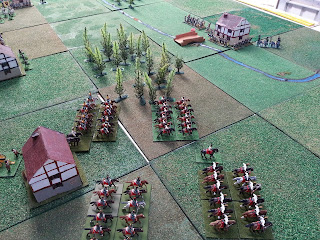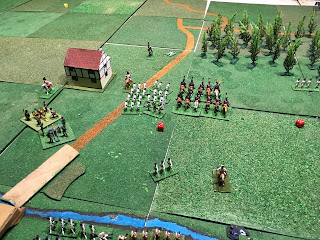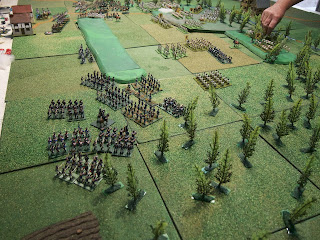My hope/plan for my part of our games in 2018/19 is to work through battles from the 1809 campaign. The battles of Raszyn (above) and Teugen-Hausen (below), roughly corps-scale actions which occurred early in the campaign (19th April 1809), were for the purpose.
Day one: Battle of Raszyn
The Austrians entered Poland at the outset of the campaign, expecting a quick victory that would secure Galicia and encouraged the Russians to enter the war. Prince Poniatowski deployed his untried Polish army, supported by a small contingent of Saxon infantry and guns, behind the Rawka (Mrowa) River around the town of Raszyn to defend Warsaw against Archduke Ferdinand d'Este's numerically superior force.
I had a scenario for Raszyn more or less developed, based on Peter Anderson's Blunders on the Danube scenario along with the one in Shako/Fields of Glory (also looking at those for Grande Armée, Volley and Bayonet and Age of Eagles) with the order of battle from John Gill's excellent Thunder on the Danube.
For this game, Stephen and Mark took the Austrians against Biko, Julian and me.

A closer look showing Raszyn (centre-left of photo above) defended by von Dyherrn's Saxons and Poles, Rozniecki's cavalry in reserve behind and part of Bieganski's small force around Michalowice at the bottom of the photo. In the top right Baron Mohr's Austrian's are moving to attack Sokolnicki's advance guard posted in and around Falenty (shown in close-up in the photo below).
(The French infantry are standing in as Poles. Regular readers will be surprised to hear that my painting ambitions yet again outstretched my output—not!)
Early success for Mohr's infantry.
The remaining Austrians arrived on the battlefield.
Ooops. There goes the artillery support!
Sokolnicki was feeling more isolated, but Poniatowski, unlike his historical counterpart, was reluctant to leave the defensive position behind the Rawka. A tactical mistake, perhaps?
von Sharouth's cavalry moved to outflank the Polish left.
"That may be; that may be, but we will match them with our lancers."
After a solid defence, Sokolnicki's command was demoralised, then retreated.
The Austrians advanced towards the causeway.
On the Polish left, Kamieniecki's artillery near Jaworow prepared to greet Sharouth's cavalry.
The Polish artillery was ineffective. Delayed by the mud, but not stopped, the Austrian heavies attacked, broke the battery, but were counter-charged by Rozniecki's lancers.
In the centre, Civalart's lead infantry drove across the causeway towards Raszyn.
Success at the first attempt!
Austrians advancing everywhere. Here we see von Pflacher's infantry trudging through the mud around the Rawka.
Back on the Polish left, the Austrian cuirassiers were on fire. Could nothing stop them?!
The Saxon's in Raszyn drove back an attack on the town,...
... while the Poles counter-attacked against the Austrians pouring across the causeway.It was beginning to look bleak for the Polish left, Rozniecki's cavalry defeated, a lone square holding back the Austrian horsemen.
Turn 12, the last of the game.
The Austrians successfully captured a sector of Raszyn, but the drive across the causeway had been somewhat blunted, although what remained of Sokolnicki's advance guard had been broken in the process.
The Polish left n'existe plus!
At game's end, the Saxo-Poles continued to hold 2/3 of Raszyn, but had lost Falenty and three divisions (Sokolnicki's advance guard, Rozniecki's cavalry and Kamieniecki's division that had been defending around Jaworow) while the Austrians had only Mohr's division in retreat.
Teugen-Hausen is one of the best known and oft-wargamed smaller actions of the Napoleonic wars. The Austrian advance into Bavaria in April 1809 caught the partially formed French-allied army, which was under the temporary command of Berthier, spread out and in a state of command limbo. Most isolated of all was Davout's III corps which formed the left of the extended line near Ratisbon. Seeing a chance to catch and destroy Davout's isolated corps, Archduke Charles ordered Hohenzollern's III Korps to attack.
Map showing the manoeuvres around the Danube on the 17th–19th April 1809 (Source: Department of History, United States Military Academy, Wikimedia Commons).
The Austrian attack of 19th April (Source: The Napoleon Series Map Archives).
For this game we simply used the order of battle from Peter Anderson's Blunders scenario with the table based on the simplified battlefield in James Arnold's Crisis on the Danube (a scenario that I had used to do a refight of the battle with my dad in the mid-90s). I used elements of both scenarios to determine the arrival of reinforcements.
Stephen and Mark once again took the Austrians, but I was joined by John to command Davout's French (Biko and Julian not being available).
Bavarian castle in the Brickner Först added for humorous and artistic effect!
Aerial view of the initial deployment.
Davout assesses the Austrian attack.
Fire!
Both sides attacked.
Davout shelters in a square of the 57e ligne as the Erzherzog Ferdinand hussars (heavily disguised) charge.
Meanwhile, the 3e ligne and Peterwardiener Grenz come to grips.
The Austrian beaux sabreurs were unable to break the infantry square.
Lusignan's 1st division advances through the wood to support Vukassovich...
... as the action hots up on both ridges.
Friant's 2nd division arrives to bolster the French.
The Austrians too receiving much needed support, in the form of (Justin) Bieber's brigade.
Vukassovich's Kaiserlichs seemed to be getting the better of the struggle with St Hilaire.
St. Julien's Austrian second division advanced on Vukassovich's left.
The Austrians were advancing everywhere.
Even capturing the northern ridge before Teugen (for now, at least).
More help for St Hilaire with the arrival of Gudin's 3rd division.
Justin Bieber was not concerned.
The northern ridge re-taken, Davout formed a grand battery. A pleasing sight for French eyes.
Boom!
All troops committed, frontline troops engaged and very much in the balance.
The Austrian corps reserve artillery (some heavily disguised as Prussians) moved into position between Vukassovich and St Julien.
They made an imposing sight for Friant's infantry (fortunately for the French, the Austrians had miscalculated—Mark finding the error and removing one battery before any firing).
Gudin began to get the upper-hand against the 'young' Bieber (I'm sure that GM Josef von Bieber was not a young man...)
The balance had tipped clearly in favour of the French with Gudin advancing on the right (above) and Friant and St Hilaire on the left (below).
With the French ascendant across the battlefield, and night falling in the real world, we called the game as a clear French victory.
The Iron Marshal encourages his troops as they drive off the last of the Austrian resistance.
The two games mirrored the historical battles, but with more decisive victories in both cases.
It was great to have Stephen, Mark, Biko, Julian and John as players in these inaugural games. A special weekend with wargaming mates; what better way to 'open' my wargame room and to enjoy a long weekend?!
A great big, public thank you to Stephen for coming out for the weekend, for all your help moving the junk from our garage and helping to set up on the table on Saturday and in setting up the terrain for both games. Also for providing some beaut photos of the weekend and the games, some of which I have included here.
Thanks, as ever, to Mark and Julian 'cause it would not have been much of a game / weekend without you both and the Austrians!
Last but not least, thanks to Mark 'Biko' and John for making the trek out to join us. The first of many games in the new venue, I hope!
- Arnold, JR (1990) Crisis On The Danube: Napoleon's Austrian Campaign of 1809. Arms and Armour Press, London. 286 pp.
- Gill, JH (2014) 1809: Thunder on the Danube: Napoleon's Defeat of the Habsburgs. Volume III: Wagram and Znaim Pen & Sword Books Limited, Barnsley, South Yorkshire, UK. Paperback Edition edition. pp. 9–20 & Appendix 1.
- GRW (2008) The Battle of Raszyn—Age of Eagles Scenario. http://napoleonicscenarios.weebly.com/uploads/2/3/7/7/2377799/raszyn_1809.pdf
- Hamack, C. (n.d.) The Battle of Raszyn 19 April 1809 a Grande Armée scenario. http://www.deepfriedhappymice.com/GA_Scen_Raszyn.pdf
- Kowalik, J., Black, P.B., Sorensen, L. and Swietliczko, S. (n.d.). Battle of Raszyn April 1809. Napoleon, His Army and Enemies. http://mapswar2.x10host.com/Raszyn_battle_War_Campaign_1809.htm
- Leach, C and Conliffe, A (1997) Raszyn April 1809. In. Fields of Glory: Historical Scenarios for Corps Sized Napoleonic Battles in Miniature. Quantum Printing, New York, NY. pp. 18–19.
- McNelly, K. (n.d.) Raszyn - 19th April 1809. https://volleyandbayonet.wordpress.com/napoleonic-scenarios/




































































